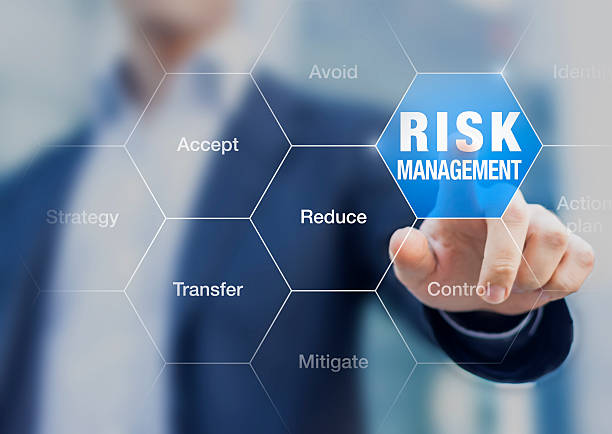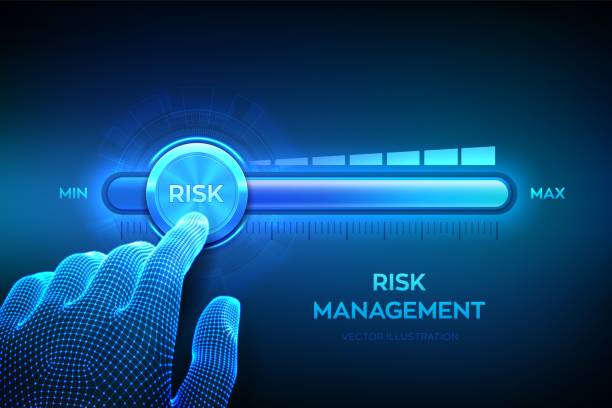Risk Management: How to identify, assess and minimize risks in the financial industry
Published

Risk management is the process of identifying, assessing and addressing risks associated with specific activities, projects or business processes. It's about identifying potential risks at an early stage and taking appropriate measures to minimize or avoid negative effects on the company or project.
In general, risk management includes the following steps:
- Risk identification: Identifying potential risks that could affect the company or project.
- Risk assessment: Assessment of risks in terms of their likelihood and impact.
- Risk treatment: Developing strategies to reduce or avoid risks and to manage risks that are unavoidable.
- Risk Control: Monitoring risks and implementing controls to ensure that the risk treatment strategies implemented are effective.
The goal of risk management is to ensure that potential risks are identified early and appropriate measures are taken to minimize the likelihood and impact of risks and thus protect the company or project from damage.
Why is risk management so important for companies and how can it help identify and minimize risks?
Risk management is important for companies for various reasons. Here are some examples:
- Protection against financial losses: Risk management helps companies identify possible risks and take appropriate measures to minimize or avoid financial losses. By protecting against financial losses, a company can ensure its financial stability and satisfy its investors and customers.
- Improve decision-making: Risk management gives companies a clear overview of their risks and opportunities. This enables them to make informed decisions to minimize risks and take advantage of opportunities.
- Compliance and legal requirements: Many industries face regulatory requirements that require risk management. Companies must meet these requirements to maintain their licensing and legal compliance.
- Improve operational efficiency: By identifying and addressing risks, the company can avoid potential problems that could impact operational efficiency. Effective risk management can improve operational efficiency and increase business success.
Risk management can help companies identify and minimize risks by:
- Risks identified at an early stage: Through regular risk analyzes and assessments, companies can identify potential risks at an early stage and take appropriate measures.
- Conducts risk assessments: A detailed assessment of risks in terms of their impact and likelihood can help companies set priorities and focus resources on the most important risks.
- Risk treatment strategies developed: Companies can develop various risk treatment strategies, such as risk avoidance, risk reduction, risk transfer or risk acceptance.
- Conducts risk controls: Through regular monitoring and controls, companies can ensure that the risk management strategies implemented are effective and that potential risks are kept in mind.
Overall, effective risk management helps companies minimize their risks and improve their business processes to promote long-term success and growth.
What are the key steps in risk management and how can companies ensure they cover all risks?
The most important steps in risk management are the following:
- Risk identification: Identify all potential risks associated with the company's business processes, projects or activities. This can be done through a systematic analysis of the business processes and the environment in which the company operates.
- Risk assessment: Assessment of the identified risks in terms of their impact and probability. The assessment can be carried out through qualitative or quantitative analysis to enable risks to be prioritized.
- Risk Treatment: Develop strategies to address risks, including avoiding, reducing, transferring, or accepting risks. Risk treatment decisions should be made based on the results of the risk assessment.
- Risk monitoring and control: Implement a system to monitor and control the identified risks to ensure that the risk treatment strategies implemented are effective. Risk controls should be carried out regularly to ensure that the risk management system is up to date.
To ensure that all risks are covered, companies should implement a comprehensive risk management system that covers all aspects of their business processes, projects and activities. A systematic approach to risk management that includes the participation of all relevant employees and continuous monitoring and adjustment of the system can help companies effectively identify and minimize potential risks.
It is also important that companies integrate a risk management system into their corporate culture to ensure that risk management is an ongoing process and not just viewed as a one-time task. This requires strong leadership, clear communication and training for all employees to ensure they understand the importance of risk management and actively participate in it.
What role do technology and automation play in risk management and how can companies use them to better manage their risks?

Those : istockphoto.com
Technology and automation are playing an increasingly important role in risk management and can help companies manage risks more effectively. Here are some ways businesses can leverage technology and automation:
- Risk analysis tools: Companies can use risk analysis tools to identify, assess and prioritize risks. These tools can rely on data analytics and algorithms to automatically detect and assess risks, saving time and resources.
- Automating risk assessment processes: Companies can automate manual risk assessment processes to minimize errors and delays. This may include, for example, the use of workflow tools that enable the automatic escalation of risks to decision makers.
- Monitoring risks: Organizations can use technology to monitor risks in real time and respond quickly to changes in the risk landscape. This can be done through the use of sensors, IoT devices or intelligent algorithms that collect and analyze data in real time.
- Automating risk management processes: Companies can use technology to automate risk management processes such as risk monitoring, reporting and compliance management. This can be done by using workflow tools or risk management platforms that automate risk management tasks and improve collaboration between teams.
Overall, technology and automation can help companies manage risk more effectively by enabling faster and more accurate data analysis, faster response time and more efficient collaboration. However, it is important that companies ensure that the technology they use is secure, reliable and compliant with applicable data protection regulations.
How can companies minimize the risks of cyberattacks and data breaches and improve their cybersecurity measures?
Cyberattacks and data breaches pose a serious threat to businesses as they can result not only in the loss of sensitive data, but also financial loss, loss of reputation and potentially even legal consequences. Here are some steps companies can take to improve their cybersecurity measures and minimize the risk of cyberattacks and data breaches:
- Employee awareness and training: Companies should train their employees on the importance of cybersecurity and best practices when processing sensitive data. Employees should be regularly informed about the latest cyber threats and trained on the proper handling of passwords, emails and other security-related processes.
- Security Policies and Procedures: Organizations should implement specific security policies and procedures that address cyberattack prevention, attack detection, and attack response. These policies should be updated regularly and made available to all employees.
- Network and system monitoring: Companies should continually monitor their networks and systems to identify signs of attacks and respond quickly. This also includes regular security checks and penetration tests.
- Regular updates and patches: Companies should ensure that their systems and applications are regularly updated with the latest updates and patches to minimize vulnerabilities and security vulnerabilities.
- Use of security software: Companies should use security software such as firewalls, antivirus software, malware protection and intrusion detection systems to protect their networks and systems.
- Third-party monitoring: Companies should also ensure that third parties, such as suppliers or contractors, who access their systems also adhere to strict security standards.
It is important to note that cybersecurity is an ongoing process and that companies should regularly update and improve their security measures to address ever-changing cyber threats.
What types of insurance are there that can help businesses manage risk and which ones should businesses consider?
There are different types of insurance that can help businesses manage risk. Here are some examples:
- Public liability insurance: This insurance covers damage caused to a third party by the company or its employees.
- Product and product liability insurance: This insurance protects the company from damage caused by its products or services.
- Property Insurance: This insurance covers damage to company property, such as buildings, equipment or inventory.
- Professional Liability Insurance: This insurance protects companies and their employees from liability caused by professional errors or omissions.
- Cyber Insurance: This insurance covers damage caused by cyber attacks, data breaches, or other cyber threats.
- D&O Insurance (Directors and Officers Liability Insurance): This insurance protects executives from liability caused by their actions or decisions within the company.
- Transport insurance: This insurance covers damage to goods that are damaged or stolen during transport.
Choosing the right insurance depends on the specific risks the company faces. Businesses should carefully assess their risks and then consider the insurance options that best fit their needs. It is also important to carefully review the coverage and terms of insurance policies to ensure the business is adequately covered. A qualified insurance advisor can help businesses assess their risks and choose the right insurance options.
How can companies integrate risk management into their business strategy and ensure risk management remains a priority?

Those : istockphoto.com
Risk management should be an integral part of a company's business strategy. Here are some steps companies can take to ensure risk management remains a priority:
- Establish clear risk management policies: Companies should establish clear risk management policies and procedures that must be followed by all employees.
- Integrating risk management into business planning: Companies should ensure that risk management is integrated into their business planning. Risks should be identified, assessed and included in decision-making.
- Creating a risk management culture: Companies should create a risk management culture in which all employees are encouraged to identify and report risks. Regular education and training should be provided to raise awareness of risks and increase employee risk awareness.
- Regular review of risk management: Companies should regularly review their risk management to ensure that it is still effective and commensurate with current risks. Risk management should adapt to changing business conditions.
- Appointment of a risk management officer: Companies should appoint a risk management officer who is responsible for implementing risk management policies and overseeing risk management.
By integrating risk management into their business strategy, companies can ensure they proactively identify and manage risks, improving their chances of success. By viewing risk management as an integral part of its business strategy, the company can ensure that risk management is continually prioritized and consistent with business objectives.
How can companies ensure their employees are adequately trained to identify and assess risks, and what training is most effective?
Employee training is an important part of risk management in companies. Here are some steps companies can take to ensure their employees are adequately trained to identify and assess risks:
- Identifying Training Needs: Companies should identify their employees' training needs by asking employees what topics and skills they need to perform their jobs safely and effectively.
- Creating Training Programs: Companies should develop training programs tailored to the specific needs of their employees. The training courses should be practical and interactive and include various learning methods such as e-learning, workshops and role-playing games.
- Regular training: Companies should provide regular training to ensure employees are aware of current threats and risks and continually improve their skills.
- Manager training: Managers should also be trained to ensure they understand the importance of risk management and can support employees in implementing risk management measures.
- Review training results: Companies should monitor and evaluate training results to ensure that training is effective and achieves desired results.
Training should focus on the specific needs of employees and the company and address current threats and risks. Some of the most effective trainings are:
- Raising awareness of cybersecurity and data protection
- Training in data protection regulations and regulatory requirements
- Training in risk assessment and risk management methods
- Emergency preparedness and business continuity training
- Training in ethical behavior and corruption prevention
By ensuring their employees are well trained, companies can improve risk awareness and employees' ability to identify and assess risks. This can help the company be better prepared for risks and manage them effectively.
What risks should startups and small businesses keep in mind and how can they minimize them when they have limited resources?
Startups and small businesses typically face a variety of risks that they should keep an eye on to ensure their long-term viability. Here are some of the key risks that startups and small businesses should keep in mind:
- Financial risks: Start-ups and small businesses often have limited resources and may not be able to finance themselves quickly enough. It is important to create a budget and monitor finances carefully.
- Market risks: Start-ups and small businesses must adapt to changing market conditions and respond quickly to changing customer needs and wishes. It is important to carry out market analyzes regularly and pay attention to current trends and developments.
- Reputation risks: A company's image is an important factor for success. Startups and small businesses should ensure they act ethically and responsibly and take customer feedback into account.
- Personnel risks: Employees are an important resource for every company. It is important to create a good working environment and to motivate and retain employees.
- Cybersecurity risks: Startups and small businesses are often targeted by cyberattacks and data breaches. It is important to take cybersecurity measures and train employees to minimize the risks.
To minimize these risks when the company has limited resources, startups and small businesses should take the following measures:
- Prioritization: Prioritize the risks that are most likely to occur and have the greatest impact and focus on minimizing those risks.
- Cost-Benefit Analysis: Conduct a cost-benefit analysis to ensure you are taking the right actions to minimize risks without wasting your limited resources.
- Collaboration: Leverage synergies by collaborating with other startups and small businesses to share resources and experiences and reduce risk mitigation costs.
- Training: Train your employees in the areas that are most important to the company to ensure they are aware and can minimize the risks.
- Continuous monitoring: Continuously monitor risks and adjust your strategies to ensure your business remains as safe as possible.
How can companies use risk management to identify and maximize business opportunities rather than just minimize risks?

Those : istockphoto.com
Risk management can help not only minimize risks, but also identify and maximize business opportunities. Here are some steps companies can take to use risk management to identify and maximize business opportunities:
- Identification of opportunities: Companies should proactively look for new business opportunities and focus on areas where they can contribute their knowledge and skills.
- Analysis of Opportunities: Companies should conduct a thorough analysis of opportunities to ensure they make economic and strategic sense. They can also assess the risks and challenges associated with developing new opportunities.
- Planning: Companies should create a plan that includes the necessary resources, timeline and strategies to implement the identified opportunities.
- Implementation: Companies should take the necessary actions to implement the opportunities and maximize the benefits.
- Continuous monitoring: Companies should continuously monitor and evaluate the implementation of opportunities to ensure that they deliver the expected benefits and to be able to make adjustments if necessary.
By integrating opportunity identification and maximization into risk management, companies can maximize their business potential, enter new markets, promote growth and increase their competitiveness. By applying risk management principles to the identification and implementation of business opportunities, companies can minimize risks while promoting the growth and success of their business.
What trends and developments are there currently in risk management, and how can companies use them to better manage their risks?
There are currently several trends and developments in risk management that companies can benefit from to better manage their risks. Here are some of the most important ones:
- Use of artificial intelligence and machine learning: Artificial intelligence (AI) and machine learning (ML) are being used more and more frequently in risk management to analyze data faster and more accurately and thus make better decisions. Companies can use these technologies to automate and improve their risk management processes.
- Advanced Analytics: Advanced analytics tools and technologies are used to quickly and accurately analyze large amounts of data to provide new insights into organizations' risks. Companies can use these technologies to better understand risks and improve their risk management strategies.
- Digital Transformation: Digital transformation is changing the way companies work and offer their products and services. Companies must adapt their risk management strategies to the new digital risks associated with the introduction of new technologies.
- Sustainability: More and more companies are paying attention to the sustainability of their business practices. Companies can identify and manage sustainability risks to minimize environmental impacts and other negative consequences.
- Cybersecurity: Cybersecurity risks are increasing due to the increasing digitalization of the business world. Companies must continually improve their cybersecurity measures and regularly train their employees to protect against cyberattacks and data breaches.
To take advantage of these trends and developments in risk management, companies should continually stay abreast of new technologies, best practices and industry trends. They should also regularly review and adapt their risk management strategies to ensure they keep pace with changing risks and challenges.








